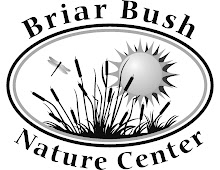Yesterday, on a cold and rainy Monday, 40 kindergarteners came to visit Briar Bush for a nature hike. Determined not to submit to the gloomy weather, the junior hikers came prepared in rain jackets, hooded sweatshirts and big smiles. As I began my hike with my small group, we stopped to look at natural wonders along the way: an uprooted tree, new leaves on trees and flowers in bloom. Then we hit the nature hike jackpot: an eastern box turtle!
This little gal wasn’t fazed by the weather at all! Cold or not, she was determined to find something tasty to eat. Much to my amusement, her beak was covered in slimy, gooey mushroom paste. Nearby, a cluster of mushrooms bore signs that looked suspiciously like box turtle bite marks… Besides mushrooms, box turtles love to eat earthworms and other invertebrates and the occasional “salad,” all of which can be found in abundance at Briar Bush.
I carefully picked up the box turtle, explaining to the children that because she was a wild box turtle and not a pet, that we would only look at her for a little bit before letting her go on her way. Understandably nervous, the box turtle hid in her shell, closing up the front using the hinge on her plastron (the bottom of her shell). It’s this ability to close their shells completely like a box that gives the box turtle its name (not because the turtles are known to sparring matches, as most children are disappointed to learn). It’s also the plastron of a turtle that will tell you if you are looking at a male or female; females’ plastrons are flat, while the plastron of a male is concave.
Having given everyone a chance to see this spectacular wildlife find, I carefully placed the box turtle back in her leafy hunting grounds. The children told the box turtle that she need not be afraid of us, and wished her well. The next time you are hiking the trails of Briar Bush, be sure to keep your eyes open for our friend, the eastern box turtle! Have a question or a story of your own to share? Post a comment below; it’s free and you don’t have to create an account!
